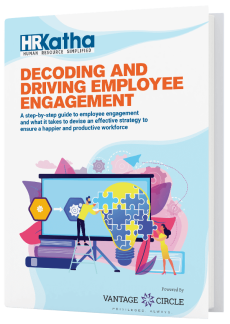Employee Engagement Survey: The Complete Insight

The term “Employee engagement” has been buzzing around in the business world for at least two decades. Employee engagement, in a nutshell, is the level of emotional connection or investment an employee feels towards the organization.
It is often difficult to interpret a concept until and unless it is quantified. The same holds for employee engagement. With that very thought, probably, the Employee engagement survey, a crucial category of the employee survey, came into play.
By the early 1990s, HR professionals started realizing that being “satisfied” or “happy” in the workplace is not enough to unlock the maximum potential of the employees.
Understanding the attitude of employees at a deeper level becomes increasingly important.
Employers needed a way to get inside the minds and hearts of their employees to know how they felt about the company and how committed they are towards the fulfillment of company goals. And with that purpose, employee engagement surveys became an integral part of organizational culture.
Traditionally these were long-form surveys conducted annually. These surveys consisted of at least 50 questions prevailing to various major concerns of the company.
Although running surveys soon became a regular event for many companies, there was a huge disconnect between employee engagement efforts and survey results.
It often took companies months to build the questionnaire and run the survey. Again analyzing the results and implementing changes took another couple of months.
Naturally, there was a significant gap in the timeline between employee needs and acting on those.
RELATED:45 Employee Engagement Survey Questions that you must ask in 2019
Employee Engagement Survey: Where are we now?
Employee engagement surveys have come a long way since then.
From long-form paper-based annual surveys, it evolved to shorter and frequent online surveys. The most common form being Pulse Surveys.
Related: A Brief Guide On Employee Pulse Surveys
An employee pulse survey is a fast and frequent survey system designed to be done quarterly, monthly, or weekly. Through the survey, employees are generally asked a few complex questions, and the same questions are repeated over a fixed period to track the progress.
In the past 5 years, pulse surveys have gained much-deserved popularity in the employee engagement space. They are effectively helping companies in creating a culture of continuous improvement in the workplace.
Josh Bersin, founder of Bersin by Deloitte and one of world’s leading researchers and advisors in talent management and HR technology, wrote about Employee engagement survey 3.0 in one of his recent articles.
According to him, Employee engagement surveys are transforming from real-time feedback systems to even more proactive surveys aided by Artificial Intelligence. The system will use intelligent Nudges to help organizations develop rules, hints, tips, and suggestions to build a more employee-oriented workplace.
While implementing the Nudge system is still in the future, you can still make the most out of your regular online surveys. And in this article, I’ll try to help you with all the major queries you might have before running a survey.
Importance of Employee Engagement Surveys
Let’s take a quick look at the role of employee engagement surveys in an organization:
-
Surveys make sure that employee engagement is the top priority in your organization. They are the best way to make sure that employees are in an emotionally secure work environment.
-
It can be the most definitive way to gauge various company concerns such as Employee Health, Employee Absenteeism, Employee Turnover, Employee productivity, etc.
-
Employee engagement surveys are the best way to track improvement within the organization and benchmark employee engagement within the industry.
-
They make employees feel heard, cared for, and looked after, leading to improved employee satisfaction and boost employee morale.
-
Conducting Survey is the only way to quantify or measure the employee engagement efforts of the organization.
-
It nurtures a culture of continuous employee feedback.
-
Employee engagement surveys are the cornerstone of cultivating a company culture that focuses on employee autonomy, employee satisfaction, and loyalty.
Components of an Employee Engagement Survey
We can not leave at the statement that employee engagement is a complex concept. Employee engagement, by all means, needs to be explored and understood by every organization. So what do you measure in an employee engagement survey?
What are the components you must not miss in your next survey?
Employee engagement surveys should have a mandatory employee engagement index section. In this section, questions should pertain to the overall engagement, the company culture, the likeliness of recommending the company to others, and how long employees feel committed to the organization. This section is a critical one because it gives you the current status of your efforts and leads you towards the company's top concerns.
Presenting 8 top components that you must evaluate in your engagement survey:
Communication:
Communication within the organization is a criterion that you must always keep in check. Are your employees having healthy horizontal and vertical communication? By horizontal communication, I mean, is there healthy peer communication in the organization? Do your employees have good communication with upper management? Is there an imbalance between conveying the message to your employees and listening to them? Uncovering all these primary concerns and measuring the effectiveness of internal communication should be a primary objective of the survey.
Leadership:
The next thing that you must uncover is the leadership style in your organization. Research by Gallup shows that managers account for 70 percent of the difference in employee engagement scores.
Leaders should be able to convey the company goals and values to the employees. They can make sure that individuals' personal goals are aligned with the company goals.
So, naturally, leaders play a huge role in making employees feel inclusive, motivated, and loyal to the organization. Understanding this aspect is highly crucial to your employee engagement efforts.
Compensation and Benefits
With the rise in the number of companies and economic stability becoming a reality, the talent acquisition and retention scenario has changed massively. Companies are now competing with one another to attract the best talent and not the other way round. Offering attractive employee perks and privileges has become an important part of the equation.
After all, who doesn't like to receive compensation over and above their hard-earned salary?
You can ask questions in your survey to evaluate your company's compensation and benefits package. You can also use it as means to identify the popular and top-seeking benefits among your workforce.
Employee Recognition:
People may take a job for more money, but they often leave it for more recognition.~ Bob Nelson.
Human beings have an inherent desire to feel valued and be appreciated. Recognition at work matters even more because when your employees feel recognized for their good work and attitude, they feel motivated. It also directly reflects their performance level. Understanding if your employees feel recognized for their conduct, hard work, and accomplishments is essential for the cumulative measure of employee engagement level in your organization.
Workplace Wellness
Your employees are spending a large amount of time in the workplace. If the work environment is not health-friendly, naturally, the wellness of your employees will be compensated. Your employees' take on the company’s wellness initiative will offer you useful insights in building a more health-focused culture. This section can include questions ranging from Office canteen, corporate wellness program, gym membership, stress-inducing elements in the workplace etc.
Personal and Professional Development
47% of higher educated workers said a limited career path could get them to leave a job. (Randstad)
For the longest time, corporations neglected the fact that employees seek a progressive career trajectory. The personal and professional development in their current job role is important to keep them engaged and motivated. The Employee engagement survey must not miss out on this point and explore areas in which they lack. This section can also help management plan their employee training programs and keep a check on their technological forwardness.
Work Environment:
This one is a no-brainer. While it might take some time to implement certain changes like building better Rewards and Recognition program, making changes to the physical environment can be done easily. Your employees might be facing certain small and big issues relating to the comfort or availability of basic amenities in the workplace. Some minor issues when goes on unattended for a more extended period may lead to disengagement. Employee engagement surveys must uncover these areas.
Work-life Balance:
The need for work-life balance cannot be overstressed. With millennials and Generation Z slowly taking over the workplace, work-life balance is now a top seeking criterion. To understand your employees' expectations from the organization for making their work and life more balanced, you must ask questions. You might want to add questions to understand their inclination towards work-from-home policies, flexible office timing options, paid vacations, and so on. Also, employee engagement surveys offer a great way to understand their current degree of work-life balance.
Implementation of Employee Engagement Survey
If you’ve reached this section, you must be pretty serious about running this survey in your organization. I highly recommend you to read my blog “A Beginner’s Guide to Conducting Employee Surveys” where I discuss the steps of running Employee Surveys in great detail.
While running all employee surveys follow a similar pathway, here are few additional tips you should keep in mind while running this particular survey:
- Only run a survey when the management and leaders are committed to making changes in your organizational culture. There cannot be a bigger mistake than running a survey, gaining the results, and not doing anything about it.
So, before you rush towards running your first survey or conducting a timely survey ritual, make sure you have an action strategy in mind. You must accept the flaws and take the necessary measures.
- Take an expert’s opinion. While the management of an organization is most aware of the happening in the office, curating a questionnaire is a whole different ball game. At this stage, it is advisable to take professional help.
Moreover, you want the ability to benchmark your results with other companies in your industry. When you opt for an external survey provider, they offer valuable benchmark data and a standard set of questions asked across the industry. It also becomes easier to ensure confidentiality.
-
Be specific and very clear with the questions. Don’t confuse the respondents with vague inquiries or unnecessary jargon. Keep the survey short and relevant.
-
A common query among management is when to run the surveys? And how often? There is no one-word answer for the same. Employee engagement surveys aim to cultivate a culture of continuous improvement in the organization. And the cycle of progress is never never-ending.
Engagement surveys should be run frequently and should become an indispensable part of company culture.

Vantage Circle is a simple AI-powered Rewards & Recognition Platform for upgrading your employee experience and engagement for better productivity.





